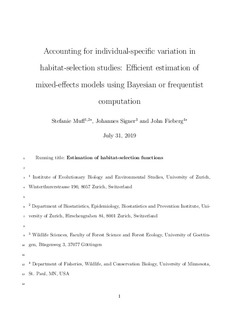| dc.description.abstract | 1. Popular frameworks for studying habitat selection include resource‐selection functions (RSFs) and step‐selection functions (SSFs), estimated using logistic and conditional logistic regression, respectively. Both frameworks compare environmental covariates associated with locations animals visit with environmental covariates at a set of locations assumed available to the animals. Conceptually, slopes that vary by individual, that is, random coefficient models, could be used to accommodate inter‐individual heterogeneity with either approach. While fitting such models for RSFs is possible with standard software for generalized linear mixed‐effects models (GLMMs), straightforward and efficient one‐step procedures for fitting SSFs with random coefficients are currently lacking.
2. To close this gap, we take advantage of the fact that the conditional logistic regression model (i.e. the SSF) is likelihood‐equivalent to a Poisson model with stratum‐specific fixed intercepts. By interpreting the intercepts as a random effect with a large (fixed) variance, inference for random‐slope models becomes feasible with standard Bayesian techniques, or with frequentist methods that allow one to fix the variance of a random effect. We compare this approach to other commonly applied alternatives, including models without random slopes and mixed conditional regression models fit using a two‐step algorithm.
3. Using data from mountain goats (Oreamnos americanus) and Eurasian otters (Lutra lutra), we illustrate that our models lead to valid and feasible inference. In addition, we conduct a simulation study to compare different estimation approaches for SSFs and to demonstrate the importance of including individual‐specific slopes when estimating individual‐ and population‐level habitat‐selection parameters.
4. By providing coded examples using integrated nested Laplace approximations (INLA) and Template Model Builder (TMB) for Bayesian and frequentist analysis via the R packages R‐INLA and glmmTMB, we hope to make efficient estimation of RSFs and SSFs with random effects accessible to anyone in the field. SSFs with individual‐specific coefficients are particularly attractive since they can provide insights into movement and habitat‐selection processes at fine‐spatial and temporal scales, but these models had previously been very challenging to fit. | nb_NO |
